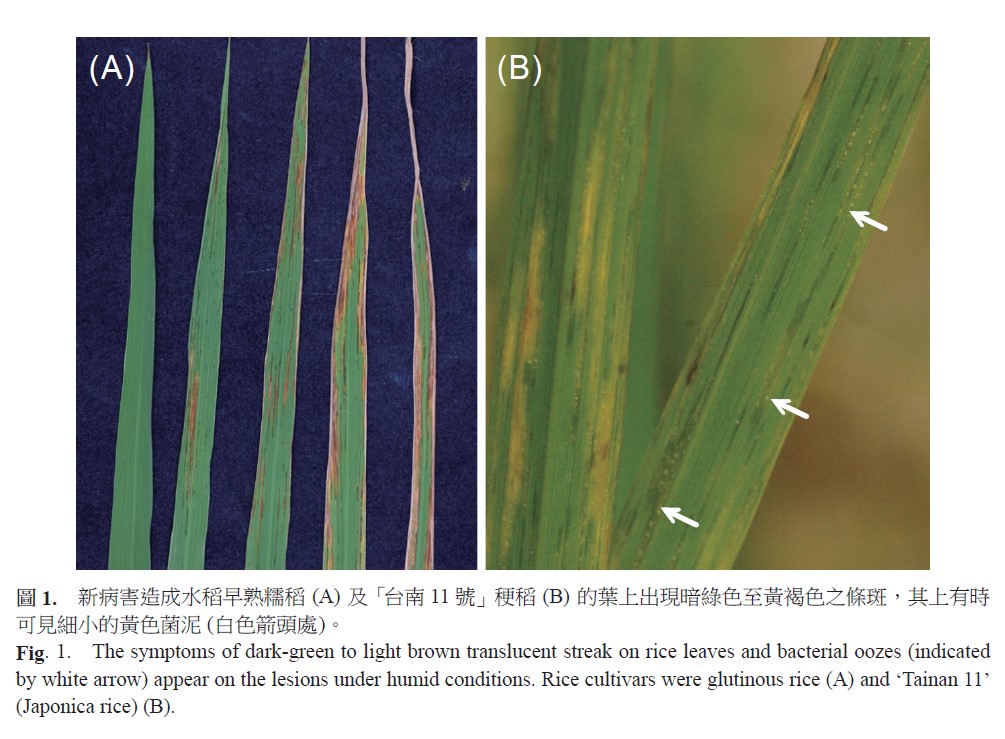All issues

Author:Chun-Wei Chen*, Shiow-Huey Hseu, Yih-Chang Chang, and Lih-Jiuan Hsieh
Abstract:
In 2007, a new disease of rice was found in Nantou and Yunlin Counties in Taiwan. The symptoms exhibited dark-green to light brown translucent streak on rice leaf, and bacterial oozes appear on the lesions under humid conditions. This disease was later found in Miaoli, Taichung, Changhua, Chyayi, Tainan, Huailien, and Taitung Counties in Taiwan. Results from 16S rDNA sequencing and comparison revealed that the nucleotide sequences shared 97% similarity with the ones of Xanthomonas oryzae pv. oryzae (Xoo), and 100% similarity with Xanthomonas oryzae pv. oryzicola BLS256. Based on the symptoms and pathological studies, 16S rDNA sequencing, and physiological and biochemical analyses, the pathogen was identified as Xanthomonas oryzae pv. oryzicola (Xoc). The susceptibility of rice cultivars to bacterial leaf streak (BLS) were tested in greenhouse. Sixteen rice cultivars were susceptible, but the disease incidence and index were different when inoculating with different Xoc strains. The virulence of Xoc strains XOCH-1 (disease index was 1.8) was lower than XOCI-1c (2.3) and XOCK-1b (3.1). The disease incidence of rice cultivars ‘Taikeng 2’, ‘Taikeng 8’, ‘Taikeng 11’, ‘Taikeng 16’ and ‘Tainan 11’ were 100%. Among them, the highest disease index was 3.6 for ‘Tainan 11’ and was 3.3 for ‘Taikeng 16’. The disease incidence of ‘Kaohsiung 145’ (41.7%), ‘Taitung 30’ (41.7%) and ‘Taikeng glutinous 1’ (78.3%) were lower than the other thirteen cultivars. Besides, ten commercial agrochemicals were tested and results showed that they can almost inhibit the growth of all tested Xoc strains. Among those, four agrochemicals could control BLS disease in greenhouse, especially spraying Mancozeb and Kasugamycin + Copper oxychloride before inoculation.
Key words:Rice, Bacterial leaf streak, Xanthomonas oryzae pv. oryzicola, Chemical control
Download:![]() PDF Links
PDF Links
- 1. Development of Tractor-Mounted Seedling Transplanter for Sweet Potato
- 2. Synergistic Effect of Additional Gas on the Toxicity of Phosphine to Sitophilus oryzae and Sitophilus zeamais (Coleoptera: Dryophthoridae)
- 3. Effects of Temperature and Solar Radiation on Growth Traits and Plant Elements in Purple Leafy Sweet Potato
 Submit your manuscript
Submit your manuscript
 Guide for authors
Guide for authors